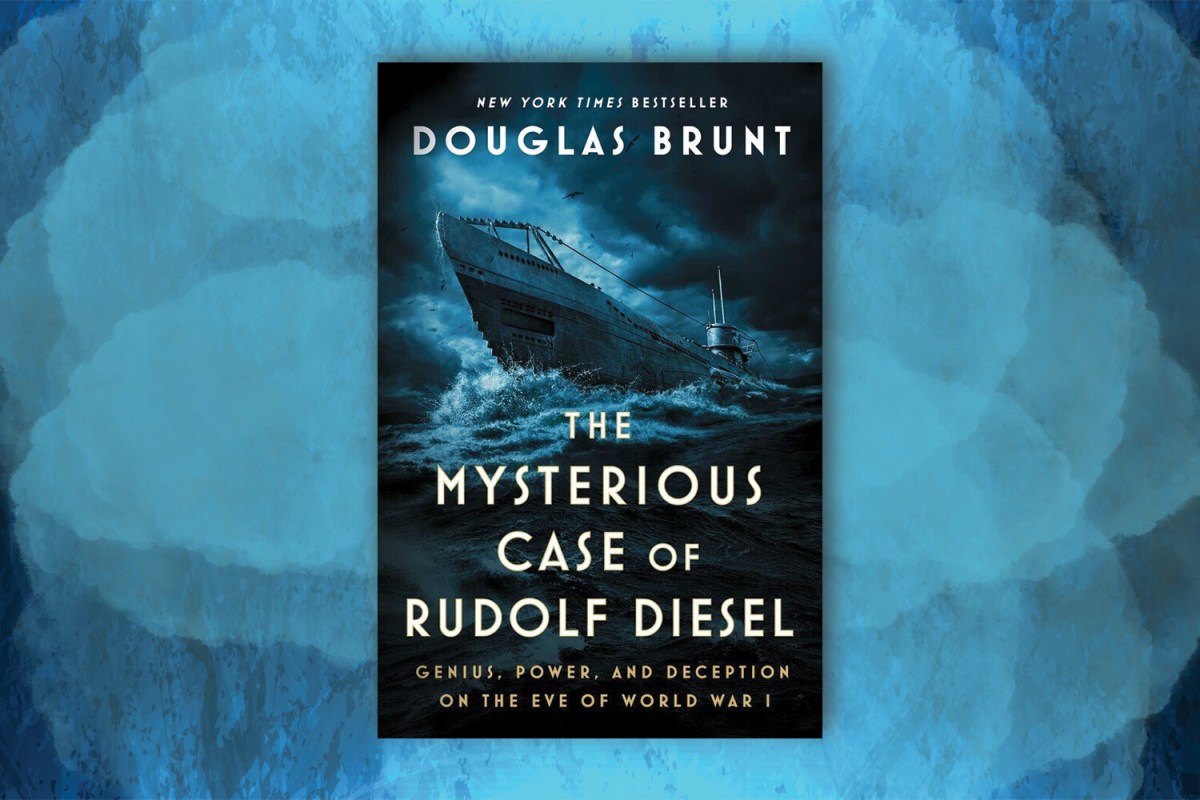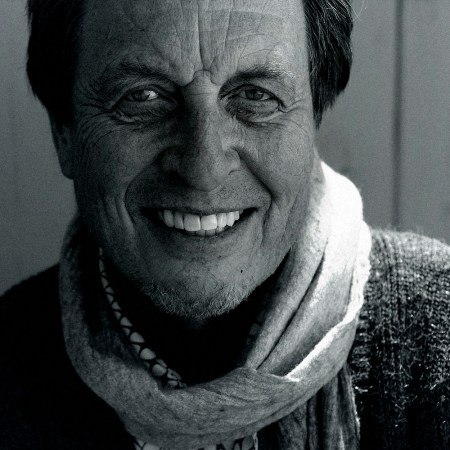Imagine the shock if an inventor and businessman who had the ears of countless world leaders and military commanders suddenly went missing. That’s not a rhetorical question, by the way — in 1913, while in the midst of a sea voyage, inventor Rudolf Diesel vanished while en route to London.
In the hundred-plus years since Diesel’s disappearance, there’s been a lot of speculation about what might have happened to him— and whether his disappearance was the result of foul play, a terrible accident or something entirely different. In his new book The Mysterious Case of Rudolf Diesel: Genius, Power, and Deception on the Eve of World War I, Douglas Brunt explores Diesel’s life and impact on the world and offers an intriguing solution to the mystery that surrounded Diesel’s exit from the world stage.
InsideHook spoke with Brunt about Diesel’s life and legacy, the unlikely directions his research went in and the early days of electric cars.
InsideHook: Early on in The Mysterious Case of Rudolf Diesel, you mention that most people spell diesel with a lowercase “d” when they’re talking about the engine. And as you pointed out, it should be capitalized because it was named after its inventor. When was the first moment you became aware that this engine’s inventor had been somewhat overlooked in technological history?
Douglas Brunt: Seven years ago, I bought an old boat, which was a little run down and needed a refresh. I was going to redo the boat a little bit, and I asked an expert what I should do. He said that I should get rid of these gasoline engines and repower them with Diesel. At the time, I didn’t know the difference between types of engines.
He said, “One hundred percent of boat fires come from gasoline engines, zero from diesel. There’s no fumes. The fuel is stable. You can drop a lit match into a barrel full of diesel fuel and nothing will happen. And the efficiency is three to four times, so if you have this 200-gallon fuel tank, you go four times as far on diesel.” So I repowered it to Diesel, still not knowing anything about this figure named Rudolf Diesel who had invented it way back in 1897.
A couple of years later, I was in-between novels. I’ve mainly written fiction and I was in-between books and Googling around trying to find ideas for a new book — anything that would spark my thinking. I came across this list of mysterious disappearances at sea, and on the list was Rudolf Diesel. I thought, “I wonder if this has any connection to my marine diesels on the boat?” And of course it does.
Rudolf Diesel disappeared while crossing the North Sea in 1913 on the eve of World War I. That kicked off this whole five-year rabbit hole of me going around archives in Europe and America and doing this investigation of a caper, really.
In the book, you pull in everything from technical diagrams to newspaper headlines to the minutes of government meetings. Where did you go to find some of the information that’s in here?
There were a couple of key spots. And as you suggest, the book accomplishes a few different things. On the one hand, the main thrust of it is that it’s a biography of Rudolf Diesel, but it’s also an investigation of his disappearance. It’s something of a murder mystery, a whodunit, but it’s also a primer on turn-of-the-century diplomacy in Europe in the quarter century running up to World War I. It’s also a “Combustion Engines for Dummies” manual, in a way.
The main treasure troves I found were primarily in Germany. There is an archive of MAN. People who are familiar with diesel engines to this day know the company MAN, M-A-N, which stands for Maschinenfabrik Augsburg -Nürnberg. That company has been through a few mergers and things since Diesel’s days of working with them as his partner to develop the engine back in the 1890s. They maintain an archive and museum related to Diesel and have many of his personal letters, effects and diaries — and corporate documents and things like that. So that was a huge trove of stuff. It was all in German, of course. So I contacted my old high school buddy who’s in the English department there, and he put me in touch with a German professor who translated reams of things for me.
There’s also a lot in the Deutsches Museum in Germany, but there are also places that had documents related to his disappearance closer to the North Sea and the ports from where he left. There’s stuff in Denmark that did a lot with early Diesel technology, particularly marine Diesel in the Netherlands. And then here in the United States, there was a lot, too, because the way they licensed the engine back then was by national territory. So he would offer a license to, for example, North America — exclusively to manufacture and market the engine in that territory. The person who took the license for North America was Adolphus Busch, the founder of Anheuser-Busch. He had licensed Diesel initially to pump water in his breweries and to power refrigeration. But he also built a separate business for Diesel for the U.S. Navy to provide submarine Diesel engines. The cast of characters in this Gilded Age era is just fascinating.
Winston Churchill shows up a few times in the book. Were you working from his memoirs for those sections, or was that information more from British government records?
A lot of it was the war museum. There are a few archives in Britain; newspaper archives were a big thing. One of the fascinating things about it was that in the two weeks after Diesel’s disappearance, headlines across the world — from New York, all through Western Europe, out to Moscow — were going crazy with the story. While he’s not a famous man now, his personal history really has been paved during v the last 120 years.
When he disappeared in 1913, it was the equivalent of Elon Musk disappearing today. It was clear in scientific circles that the Diesel engine was going to dominate certain industries that were coming to dominate the world, like the railroads and merchant marine vessels. The heads of each Navy of the great powers knew Diesel was on the way. It was the only way to power a submarine.
At the time, they were in the midst of a terrible Anglo-German naval arms race. Both were scrambling for Diesel power, and the Diesel engine was young enough that Rudolf Diesel himself was still the main source of knowledge on how to apply that engine to different environments like a submarine or U-boat.
Who would you say was the closest contemporary figure to Diesel at the time of his disappearance?
I would say Musk is the closest. I mean, Diesel was not the richest man in the world, but he was critical to military efforts at that time the way that Musk has his satellites doing things in Ukraine.
Because of that naval arms race, Germany couldn’t keep up with Great Britain. From the time of Napoleon’s defeat in 1815 on, Great Britain dominated the sea lanes. They had the most powerful navy and the largest and most expensive merchant marine fleet. Germany had the greatest land army and was growing industrially leaps and bounds, even faster than Great Britain. And they felt in order to fuel their growth, they needed an imperial structure — in fairness, much like Britain already had.
In order to do that, they needed a stronger navy, and they couldn’t compete with the British dreadnoughts and their capital ships. They had a leg up in submarine or U-boat technology and developed a U-boat fleet, for which Diesel’s technology was critical. It was the only engine that could power submarines — certainly a steam engine couldn’t do it. Gasoline and kerosene engines couldn’t do it; they were constantly having fires and explosions and fumes, and they didn’t have the range to get a U-boat out into open sea lanes.
So when Diesel disappeared in 1913, many of the newspapers thought it was murder. The prevailing theory was suicide, but many people thought he was murdered either by Rockefeller or by Kaiser Wilhelm, the emperor of Germany, for these reasons. One of the reasons he was going across the North Sea on that day in September of 1913 was because he was co-founder and board director of a newly established Diesel engine manufacturing company in Great Britain whose mandate was to build Diesel submarines for the Royal Navy, which of course would outrage Kaiser Wilhelm.
I don’t want to spoil too much about where the narrative of the book goes, but you bring up a few different theories about what might have happened to Diesel. Have those waxed and waned in terms of popularity over the years? And have you gotten any kind of a reaction to the solution that you posit in the book?
The prevailing theory, what you’ll find in the Encyclopedia Britannica and other biographies of Diesel, is everyone presumes it was suicide. The other theory that emerged in the weeks after his disappearance was murder, either by Kaiser Wilhelm or by big oil. I posit something else. I don’t want to spoil it for anyone, but I’ll tell you this much: it’s not suicide. The holes in each of those theories are massive.
The book begins as the story of the origins of Diesel and the incredible importance of Diesel technology for both industry and war. And to this day, if you imagine a piece of fruit grown in a tropical region, all the heavy machinery and farm equipment used to grow it are Diesel-powered. It gets loaded onto a truck that’s Diesel-powered. It goes to the port where a crane, Diesel-powered, loads it onto a cargo ship, 100% of which are Diesel-powered. It goes across the oceans, it’s loaded using a crane onto a truck, then onto a train — 100% of trains are Diesel-powered. Our whole global economy has been built and still relies on Diesel.
One of the smaller details in there that really stayed with me was the fact that there was a fleet of 1,000 electric taxis driving through the streets of New York with charging stations everywhere in the early days of the 20th century.
That was in 1905.
It’s a reminder that electric vehicles are not a new technology at all; it’s more of a rediscovery of something older.
There was a fleet of hundreds of New York City taxis, all electric, with a power charging station on Broadway in Times Square. And Thomas Edison was working on the batteries for these electric cars in connection with Henry Ford. So the idea that gasoline and petroleum, crude oil pulled from the ground, was going to be our main fuel source for the 20th century was not a settled thing early in the 1900s.
Rockefeller was very much on the ropes at that time. He had made all his money from the founding of Standard Oil in 1870 to the end of that century. He became the richest man in the world because he was in the illumination business. He was distilling crude oil out of the ground to make kerosene and throwing the gasoline away, which was just a nuisance byproduct of the distillation process. He was selling kerosene for lighting. Then the electric light bulb came along, with Edison and others developing light bulbs, which wiped out kerosene lamps in much the same way that kerosene wiped out the whaling industry, as we used to use whale blubber for lamps.
So Rockefeller needed a different revenue source as the kerosene illumination market was going through the floor. We didn’t start selling or consuming more gasoline than kerosene until 1916. But he recognized that kerosene was going away for him, and he needed the world to become addicted to the combustion engine burning gasoline. And therein is why Diesel was a threat — because Diesel ran the 1900 World’s Fair in Paris on a Diesel engine running peanut oil.
Diesel argued we didn’t need to use petroleum. Almost every country has farmers and an agricultural capacity. We can grow our own fuel domestically and don’t need to run around the world. And as recently as 15 years ago, Willie Nelson’s driving around on his tour in a bus running a Diesel engine that burns recycled kitchen grease for the same reason, saying, look, we’ve got farmers. We don’t need to run around fighting wars around the world to acquire fuel.
How Icemaking Changed Cocktail History Forever
An interview with Amy Brady, author of “Ice: From Mixed Drinks to Skating Rinks — A Cool History of a Hot Commodity”In your book, you note that Diesel was not a huge fan of labor unions, but he also was not a Social Darwinist, believing that success in business meant you were a better person. Did you see him as ahead of his time or more embodying the best qualities of his time?
Maybe the best qualities of his time in that sense, from a social perspective. From a technological perspective, ahead of his time. I would call him a utopian capitalist. One of the main motivations for him building a more efficient engine and a more compact engine was to give a reliable power source to rural businesses and artisans. His father was a leather worker — a bookbinder who made leather goods and things like that at a time when a steam engine was as big as the workshop.
Diesel wanted to build a small, compact engine that could be a power source for these kinds of decentralized businesses. In terms of the labor unions you mentioned there, I mean, his key goal was always efficiency. So if a labor union got in the way and said, look, you can’t use this mechanized way of blowing glass bottles, you need to have a man do it by hand, he would have said, “Well, that’s stupid. It’s faster and cheaper and better to do it this way. We can make better bottles more quickly and more cheaply.”
But he also was looking to kind of improve the conditions of the industrial age. I mean, one of the reasons for that is he was of Germanic origin. Germany didn’t yet exist as a state, as we have come to know it; at that time, there were 39 different kingdoms. He was born in 1858 in Paris. When the Franco-Prussian War started again, Prussia being one of the other German states, they were expelled from France because of the German association in their war with Prussia.
His family fled rioting mobs out of Paris and went to London, where they lived in tenement housing. They’re in the same locality as the place where Charles Dickens set Oliver Twist; Rudolf gets there at the same age as Oliver Twist. He was 12 years old, and he saw the worst things of the industrial age: little kids not going to school but getting marched off into factories that have no ventilation and working terribly long hours. That was a motivating phase of his life: to develop a better power source to improve the conditions of those living in that period.
Was there anything you found in the archives that changed your understanding of the project?
It seemed to slowly grow in significance when I realized how big it was for the military, for naval efforts. And then I’d find some crazy thing out — like how the Germans, in World War II, built tanks like the Panzer that all ran on gasoline engines. The best tank of World War II was the Soviet T-34 diesel-powered. So the Germans might overrun a Russian camp and, of course, they’d be running out of fuel. They’d find all this fuel, which would be Diesel fuel for the Russian tanks, and they couldn’t use it.
Every Allied naval craft that was a part of a D-Day landing was Diesel. After that effort, the admirals were so complimentary. The engines worked flawlessly. So what I discovered was while there is this massive deficit of appreciation for Rudolf Diesel, once you stop and take a look, he’s right beneath the surface of everything. Nothing in the 20th century moved without Rudolf Diesel’s invention, which — incredibly — to this day operates in fundamentally the same way as the engine he introduced in 1897.
Was there anything particularly fascinating you learned when researching this that didn’t quite fit into the overarching book?
There are 200 pages on the editing floor of things because I would completely geek out on submarines and then I’d start talking about torpedoes. I could go down so many different paths. The Zeppelins initially had gas engines, but Diesel and Count Zeppelin were friendly.
In 1900 or 1901, Count Zeppelin said, “You’ve got to build a diesel engine for me. It’ll be so much more efficient.” And he eventually did the Hindenburg — and this had nothing to do with the Hindenburg fire, but the Hindenburg was running Diesel engines. The fire was related to the gas and the airship, not the engine itself.
They had to find a way to build a diesel that was light enough to be used in an airship. Initially, the gasoline engines were the better fit because they’re lighter. And the Diesel engine is a heavy torque engine — it’s great for farm equipment and heavy machinery and trucks because you’ve got that torque, that sort of acceleration that pushes you into the back of your seat as you take off, but less on the high end. It’s just fascinating to see where it shows up in history.
This article appeared in an InsideHook newsletter. Sign up for free to get more on travel, wellness, style, drinking, and culture.

























